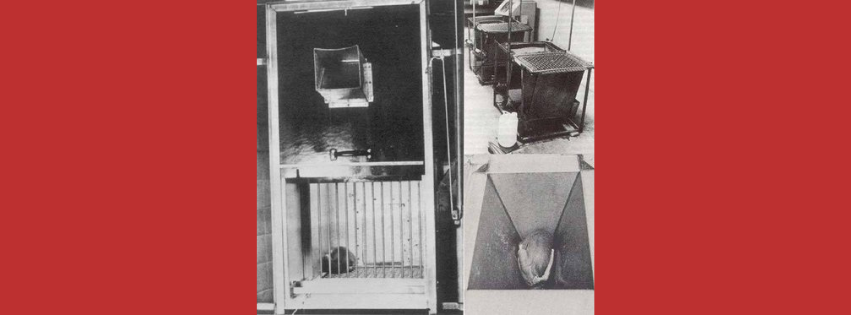
Introduction: A Glimpse into the Mind of Harry Harlow
In the world of psychological research, certain names echo through the halls of academia with both reverence and unease. One such name is Harry Frederick Harlow. Revered for his insights yet criticized for his methods, Harlow’s legacy is tied to one of the most haunting series of experiments in behavioral science history: the Harlow Monkey Experiments.
Conducted during the 1950s and 1960s at the University of Wisconsin–Madison, Harlow’s research sought to address a deceptively simple question: What is the nature of love? This was no poetic inquiry. For Harlow, love needed to be measurable, observable, and experimental. But in attempting to study love, he turned the lab into a setting of emotional torment and scientific revelation.
🧬 The Love Test: Cloth Mother vs. Wire Mother
Harlow’s first major experiment was elegant in its cruelty and brilliant in its design. Infant rhesus monkeys were separated from their biological mothers hours after birth and placed in cages with two surrogate mothers:
- Wire Mother: Made of cold metal wires, this surrogate held a bottle to feed the monkey.
- Cloth Mother: Covered in soft terrycloth, it offered no food but radiated warmth and comfort.
📊 Key Observations:
- The baby monkeys consistently clung to the cloth mother for an average of 17-18 hours a day.
- Even when hungry, they would dash to the wire mother for feeding, then quickly return to the cloth mother.
- When frightened (e.g., by a loud noise or a mechanical toy), the monkeys ran to the cloth mother, not the food-giving wire one.
🧠 What It Revealed:
Harlow shattered the then-prevailing behaviorist notion that affection was just a byproduct of food. He proved that contact comfort is a critical component in forming emotional attachments.
This was a pivotal moment in psychology—suggesting that love was not an abstract concept but a biologically and emotionally essential component of development.
🕳️ Into the Abyss: The Pit of Despair
With early success, Harlow delved deeper into the darker corridors of emotional development. He built a device called the vertical chamber, ominously nicknamed the “Pit of Despair”. It was a steel enclosure with sloping sides that prevented climbing or escape, plunging baby monkeys into total isolation.
Monkeys placed in this chamber for 30 days to 12 months emerged as psychological ruins:
- They sat hunched, motionless, refusing food.
- Many rocked themselves back and forth, a classic sign of severe trauma.
- Some injured themselves; others developed intense social phobia.
Harlow had succeeded in creating clinical depression in an animal model. It was both horrific and groundbreaking. The findings pointed to the irreversible consequences of emotional neglect, especially during early development.
🤪 Twisted Bonding: The Monster Mothers
To further understand abusive caregiving, Harlow created surrogate mothers that lashed out at the infants:
- Some had spiked surfaces.
- Others blew puffs of air or emitted startling noises.
Despite these aversive features, the baby monkeys kept returning to these abusive mothers. This shocking revelation laid the groundwork for understanding trauma bonding and Stockholm Syndrome in humans.
It begged the question: What happens when the only source of comfort is also the source of pain?
🧠 Hope in Therapy: The Therapist Monkeys
Not all of Harlow’s experiments ended in despair. In later studies, Harlow attempted to rehabilitate isolated monkeys by introducing them to socialized peers, often called “therapist monkeys.”
🙏 Results:
- 3-month isolates began showing signs of play and interaction within weeks.
- 6-month isolates required more time but showed gradual improvement.
- 12-month isolates often failed to recover, remaining withdrawn and anxious.
This reinforced the idea of a critical window in psychological development. Miss it, and the damage might be permanent.
🧥 Real-World Impact: How Harlow Changed Everything
Harlow’s work wasn’t just theoretical. It redefined:
- Parenting and caregiving: Skin-to-skin contact, affection, and bonding became recognized as essential.
- Orphanage reform: Institutional care models shifted to prioritize emotional attachment.
- Trauma psychology: Provided insight into long-term effects of neglect and abuse.
- Attachment theory: His findings were foundational for later theories by Bowlby and Ainsworth.
However, his work also triggered an ethical revolution in animal research. Today, such experiments would be deemed unethical and illegal in most parts of the world.
⚖️ Ethical Storm: A Legacy in Question
Harlow’s methods remain one of the most controversial chapters in science. Critics accused him of unnecessary cruelty, and his personal life—marred by depression and alcoholism—raised questions about how much his own mental health shaped his work.
Yet, even those who condemn his approach acknowledge the lasting value of his contributions. He dared to quantify love and proved that its absence has measurable, devastating consequences.
Frequently Asked Questions
- What motivated Harry Harlow to study attachment in rhesus monkeys?
- Harlow was intrigued by the nature of love and affection, aiming to understand the underlying mechanisms of attachment beyond basic physiological needs.
- How did Harlow’s findings challenge existing beliefs about mother-infant bonds?
- His research demonstrated that comfort and tactile stimulation are crucial for attachment, challenging the notion that feeding is the primary basis for mother-infant bonds.
- What were the long-term effects observed in monkeys subjected to total isolation?
- Monkeys exposed to prolonged isolation exhibited severe social and emotional impairments, including depression-like behaviors and difficulties in social integration.
- How did Harlow’s experiments influence human parenting practices?
- The findings emphasized the importance of physical affection and emotional support in child-rearing, leading to more nurturing parenting approaches.
- What were the main ethical criticisms of Harlow’s research methods?
- Critics argued that the experiments caused unnecessary psychological distress to the animals, raising concerns about the morality of such research practices.
- Did Harlow’s work have any impact on policies regarding child care?
- Yes, his research influenced policies by highlighting the significance of early emotional bonds, leading to reforms in orphanage care and adoption practices.
- How did the scientific community initially react to Harlow’s findings?
- While many acknowledged the groundbreaking nature of his work, others criticized the ethical implications and generalizability of the findings to humans.
- What alternative methods could have been used to study attachment without ethical concerns?
- Researchers could have employed observational studies in naturalistic settings or utilized non-invasive techniques to study attachment behaviors.
- How did Harlow’s personal experiences influence his research focus?
- Some suggest that Harlow’s own struggles with relationships and emotional connections may have driven his interest in studying affection and attachment.
- What role did Harlow’s research play in the development of attachment theory?
- His empirical findings provided foundational support for attachment theory, illustrating the importance of caregiver-infant bonds in development.
- Were there any differences in attachment behaviors between male and female infant monkeys in Harlow’s studies?
- Harlow’s experiments did not specifically focus on gender differences in attachment behaviors, so any such variations were not systematically reported.
- How did Harlow’s work influence subsequent research on human attachment?
- It paved the way for extensive studies on human attachment, influencing theories proposed by psychologists like John Bowlby and Mary Ainsworth.
- What were the specific behaviors exhibited by isolated monkeys upon reintroduction to social groups?
- Isolated monkeys often displayed fear, withdrawal, and abnormal social interactions when reintroduced to their peers.
- Did Harlow’s experiments consider the role of the father in attachment?
- Harlow’s studies primarily focused on the mother-infant bond, with limited exploration of paternal roles in attachment.
- How did Harlow’s findings relate to the concept of ‘contact comfort’?
- His research introduced the term ‘contact comfort’ to describe the intrinsic need for physical touch and comfort in forming attachments.
- What were the physiological effects observed in monkeys deprived of maternal contact?
- Monkeys deprived of maternal contact exhibited signs of stress, such as weight loss and compromised immune function.
- How did Harlow’s work contribute to understanding the effects of child neglect?
- It highlighted the detrimental impact of emotional and social deprivation, informing interventions for neglected children.
- Did Harlow’s experiments examine the role of peer relationships in social development?
- Yes, Harlow found that peer interactions were crucial for social development, especially for monkeys isolated from maternal figures.
- How did the duration of isolation affect the behavioral outcomes in monkeys?
- Longer isolation periods led to more severe behavioral abnormalities, including increased aggression and social withdrawal.
- Were the monkeys able to recover from the effects of isolation?
- Partial recovery was observed when isolated monkeys were later exposed to younger peers, but severe cases showed lasting social deficits.
- Did Harlow’s research explore the impact of environmental enrichment on isolated monkeys?
- Limited exploration was done, but environmental enrichment showed some improvement in social behaviors among isolated monkeys.
- How did Harlow’s findings influence child psychology and development theories?
- His work underscored the importance of early emotional bonds, influencing attachment theory and child development practices.
- What were the key differences between cloth mother and wire mother in terms of attachment?
- Monkeys preferred the cloth mother for comfort and security, while the wire mother was approached only for feeding.
- How did Harlow measure attachment behaviors in monkeys?
- He observed behaviors such as clinging, vocalizations, and proximity-seeking towards the surrogate mothers.
- Did Harlow’s experiments explore the concept of separation anxiety?
- Yes, infant monkeys showed signs of distress and anxiety when separated from their preferred cloth mother.
- What were the long-term emotional effects on monkeys raised without maternal figures?
- They exhibited anxiety, social awkwardness, and difficulty in forming bonds even in adulthood.
- How did Harlow’s research contribute to understanding human childhood disorders?
- It provided insights into conditions like reactive attachment disorder and the effects of neglect or abuse.
- Were there cultural influences on the interpretation of Harlow’s findings?
- Interpretations varied, with some cultures emphasizing communal caregiving versus individual mother-infant bonds.
- How did Harlow’s methods influence future research on animal behavior?
- His innovative use of surrogate mothers inspired more sophisticated behavioral studies in primatology.
- Did Harlow collaborate with other psychologists during his research?
- He collaborated with colleagues in developmental psychology and primatology to validate his findings.
- How did Harlow address the ethical concerns raised by his research?
- Harlow defended his methods by emphasizing the scientific value of his findings, though his responses were controversial.
- What were the main criticisms of Harlow’s experimental design?
- Critics argued that the artificial setting and severe isolation were ethically problematic and potentially influenced the outcomes.
- How did Harlow’s personal beliefs about love and attachment shape his experiments?
- His skepticism towards behaviorism led him to explore the emotional components of attachment.
- What technological advancements did Harlow use in his experiments?
- He utilized innovative apparatuses like the “pit of despair” to study depression-like behaviors in isolated monkeys.
- Did Harlow’s findings have implications for animal welfare and husbandry?
- Yes, his work influenced practices in zoos and research facilities to provide social and emotional stimulation for primates.
- How did Harlow’s experiments compare with contemporary attachment research?
- Unlike modern attachment studies focusing on naturalistic observations, Harlow employed controlled laboratory experiments.
- What role did the University of Wisconsin play in Harlow’s research?
- The university provided the facilities and support for Harlow’s primate research, establishing a leading primate laboratory.
- Did Harlow study the impact of different types of touch on attachment?
- He observed that soft tactile stimulation from the cloth mother was crucial for emotional security.
- How did Harlow’s findings influence the field of developmental psychopathology?
- His work highlighted the long-term psychological impacts of early emotional deprivation.
- What was the societal reaction to Harlow’s findings at the time?
- While his research was celebrated for its scientific breakthroughs, it also sparked public outcry over ethical concerns.
- Did Harlow’s experiments explore the role of vocalizations in attachment?
- Yes, distressed infant monkeys vocalized more frequently when separated from the cloth mother.
- How did Harlow’s findings contribute to understanding maternal deprivation?
- His work demonstrated the severe emotional and social consequences of maternal separation.
- Were there any gender biases in the interpretation of Harlow’s experiments?
- Some critiques noted a focus on maternal figures, neglecting the role of paternal involvement in attachment.
- How did Harlow’s research influence the study of grief and loss?
- It provided a model for understanding emotional responses to separation and loss.
- What are the modern ethical guidelines for conducting similar experiments?
- Current guidelines require minimizing distress and ensuring social companionship for primates in research settings.
- Did Harlow’s research address the impact of early trauma on adult behavior?
- His longitudinal observations indicated that early emotional neglect led to maladaptive adult behaviors.
- How did Harlow’s experiments relate to the concept of ‘safe base’ in attachment theory?
- The cloth mother acted as a safe base, encouraging exploration and reducing anxiety in the infant monkeys.
- What were the educational implications of Harlow’s findings?
- His research emphasized the importance of emotional support and security in early childhood education.
- How did Harlow’s findings influence child adoption practices?
- His work highlighted the importance of emotional bonding, influencing adoption policies to prioritize early caregiver-infant attachments.
- What is the contemporary view of Harlow’s legacy in psychology?
- While recognized for his contributions to attachment theory, his methods remain controversial due to ethical concerns.





























